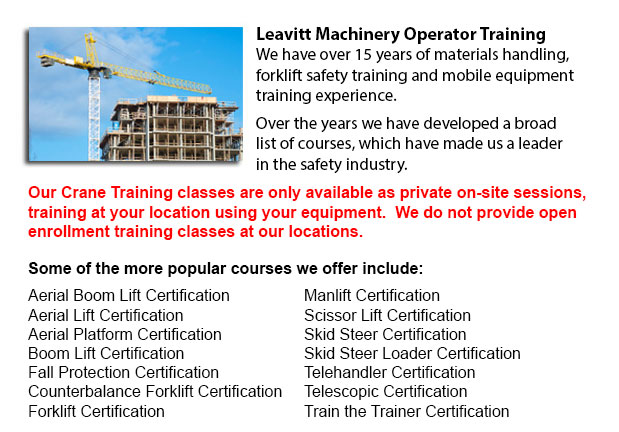
London Crane Safety Training - Both crane driver and their employers should know all the potential problems connected to the operation of an overhead crane. All across North America, there is legislation which provides rules for the safe operation, inspection and maintenance of lifting machines. Crane Safety courses truly help owners and managers of cranes accredit their operators in accordance with provincial legislation.
Our operator safety training course will provide the crane driver trainee with all of the required skills and knowledge to be able to make lifting making use of a crane easier and safer. Training the operator truly helps to lengthen the crane's life span by guaranteeing high performance and safe operation of the crane.
Accredited operators are required to run and operate articulated cranes under 16,000 lbs. capacity. The articulated crane driver needs to have knowledge concerning the various operational features and characteristics of the machinery. Prior to use, a pre-operational equipment check needs to be done. There is a legal requirement to perform a pre-operational check and an inspection of the overhead conditions and work-site ground.
The guidelines provided in the manufacturer handbook gives information on inspection, maintenance, and unloading and loading operations. Based on legislation, annual and daily checks are mandatory. Operators are needed to maintain an up-to-date logbook in nearly all regions. They might be required to validate machine warranties.
It is suggested that businesses add remote control devices to their cranes. Remote control enhances safety by enabling the driver an easier alternative for handling the crane.
Placing a high priority on crane safety helps a company's bottom line. Companies that follow safe machine practices generally enjoy greater cost savings compared to those which don't. The possibility of equipment damage and personal injury is very much reduced when a well trained driver is handling the crane. Safety conscious operators are much more productive resulting in reduced times required for unloading and loading.
-
London Crane License
London Crane License - Crane operators ought to be "credentialed", that means they must possess a crane operator license or certification. Credentialing is considered a mandatory governmental requirement in order to practice as a crane operator. Obta... More -
London Heavy Equipment Operator Training
London Heavy Equipment Operator Training - Training facilities which offer quality standards in the industry and not just provide field performing tasks but added equipment training are highly sought after. Accredited schools provide students the kno... More -
Telehandler Training in London
Telescopic handlers usually referred to as telehandlers for short, are a very popular piece of heavy construction machinery. They are usually utilized in the agriculture and construction industries. These machines have maximum reaching capacity and c... More -
London Boom Lift Certification
London Boom Lift Certification - Elevated work platforms allow maintenance operations and work to be carried out at heights which could not be reached by any other means. Workers utilizing boom lifts and scissor lifts can learn how to safely operate... More -
London Fall Protection Ticket
London Fall Protection Ticket - Fall-related accidents are the number one reason of death within the construction industry. The potential for fall incidents really increases based upon the kind of work that is being completed within your workplace. T... More -
London Forklift Safety Training
London Forklift Safety Training - Anybody who wants to operate a lift truck should take a forklift safety training program to become a certified forklift truck operator. There are several ways to obtain forklift training. Programs are provided throug... More -
Operator Safety Training, Re-Qualification Training, In-House Instructor Training in London
Lift trucks are used in nearly all warehouse operations and in boat yards and in industrial construction sites. The reach feature of a forklift is a vital component used in various applications like for instance whenever a shelving system is being us... More -
London Boom Lift Safety Training
London Boom Lift Safey Training - Boom lifts are a type of elevated work platform or aerial lifting device that are commonly utilized in construction, industry, and warehousing. Boom lifts can be used in practically any surroundings due to their vers... More

Forklift Certification London
TOLL FREE: 1-888-254-6157
London, Ontario
forkliftcertificationlondon.com
Email Us
About Us


